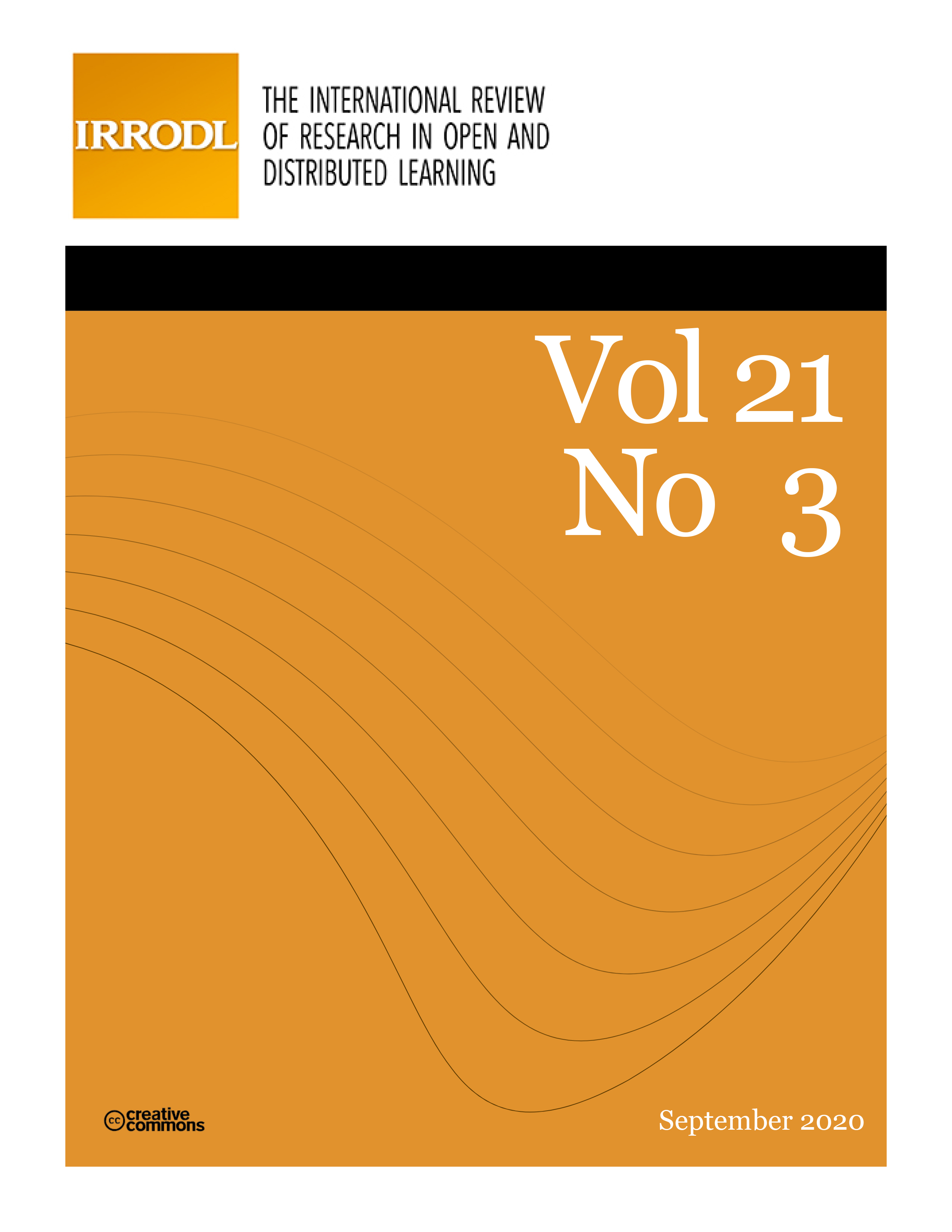Résumés
Abstract
Teachers in K–12 schools have shown an increasing desire for open educational resources (OER) to ensure all students can learn effectively. OER provide teachers with free access to open-licensed educational resources that they can retain, reuse, revise, remix, and redistribute for personalized instruction. Open educational practices (OEP) have been considered a pathway to reinforce the acceptance and readiness of K–12 teachers to use OER. This research thus showcases a qualitative study that investigates teachers’ experiences with OEP. This research explains K-12 teachers’ perceived benefits of implementing OER and also discusses their perceived barriers hindering OER usage in K–12 settings. The study also discusses the practical implications of integrating OER in K–12 curriculum.
Keywords:
- open educational resources,
- open educational practices,
- k-12,
- teachers,
- barriers,
- benefits,
- qualitative inquiry
Parties annexes
Bibliography
- Blomgren, C. (2018). OER awareness and use: The affinity between higher education and K-12. International Review of Research in Open and Distributed Learning, 19(2), 55-70. doi: 10.19173/irrodl.v19i2.3431
- Bowen, G. A. (2006). Grounded theory and sensitizing concepts. International Journal of Qualitative Methods, 5(3), 12-23. doi: 10.1177/160940690600500304
- Boyatzis, R. (1998). Transforming qualitative information: Thematic analysis and code development. Thousand Oaks, CA: Sage.
- Braun, V., & Clarke, V. (2006). Using thematic analysis in psychology. Qualitative Research in Psychology, 3(2), 77-101. doi: 10.1191/1478088706qp063oa
- Creswell, J. W. (2007). Qualitative inquiry and research design: Choosing among five traditions (2nd ed.). Thousand Oaks, CA: Sage.
- Cronin, C. (2017). Openness and praxis: Exploring the use of open educational practices in higher education. The International Review of Research in Open and Distributed Learning, 18(5), 1-21. doi: 10.19173/irrodl.v18i5.3096
- Davis, F. D. (1989). Perceived usefulness, perceived ease of use, and user acceptance of information technology. MIS Quarterly, 13(3), 319-340. doi: 10.2307/249008
- Davis F. D., Bagozzi R. P., & Warshaw P. R. (1989). User acceptance of computer technology: A comparison of two theoretical models. Management Science, 35, 928-1003. doi: 10.1287/mnsc.35.8.982
- Ertmer, P. A., Ottenbreit-Leftwich, A. T., Sadik, O., Sendurur, E., & Sendurur, P. (2012). Teacher beliefs and technology integration practices: A critical relationship. Computers & Education, 59(2), 423-435. doi: 10.1016/j.compedu.2012.02.001
- Fereday, J., & Muir-Cochrane, E. (2006). Demonstrating rigor using thematic analysis: A hybrid approach of inductive and deductive coding and theme development. International Journal of Qualitative Methods, 5(1), 80-92. doi: 10.1177/160940690600500107
- Granić, A., & Marangunić, N. (2019). Technology acceptance model in educational context: A systematic literature review. British Journal of Educational Technology , 50(5), 2572-2593. doi: 10.1111/bjet.12864
- Hassall, C., & Lewis, D. I. (2016). Institutional and technological barriers to the use of open educational resources (OERs) in physiology and medical education. Advances in Physiology Education, 41(1), 77-81. doi: 10.1152/advan.00171.2016
- Hew, K. F., & Brush, T. (2007). Integrating technology into K-12 teaching and learning: Current knowledge gaps and recommendations for future research. Educational Technology Research and Development, 55(3), 223-252. doi: 10.1007/s11423-006-9022-5
- Hilton, J. (2016). Open educational resources and college textbook choices: A review of research on efficacy and perceptions. Educational Technology Research and Development, 64(4), 573-590. doi: 10.1007/s11423-016-9434-9
- Hilton III, J., Larsen, R., Wiley, D., & Fischer, L. (2019). Substituting open educational resources for commercial curriculum materials: Effects on student mathematics achievement in elementary schools. Research in Mathematics Education, 21(1), 60-76. doi: 10.1080/14794802.2019.1573150
- Kelly, H. (2014). A path analysis of educator perceptions of open educational resources using the technology acceptance model. The International Review of Research in Open and Distributed Learning, 15(2), 26-42. doi: 10.19173/irrodl.v15i2.1715
- Kimmons, R. (2015). OER quality and adaptation in K-12: Comparing teacher evaluations of copyright-restricted, open, and open/adapted textbooks. The International Review of Research in Open and Distributed Learning, 16(5), 39-57. doi: 10.19173/irrodl.v16i5.2341
- Kimmons, R. (2016). Expansive openness in teacher practice. Teachers College Record, 118(9), 1-34. Retrieved from https://www.tcrecord.org/Content.asp?ContentId=21521
- Lin, Y. J., & Tang, H. (2017). Exploring student perceptions of the use of open educational resources to reduce statistics anxiety. Journal of Formative Design in Learning, 1(2), 110-125. doi: 10.1007/s41686-017-0007-z
- Merriam, S. B. (1998). Qualitative research and case study applications in education. Jossey-Bass Publishers: San Francisco, CA.
- Morales, R., & Baker, A. (2018). Secondary students’ perceptions of open science textbooks. Journal of Interactive Media in Education, 2018(1). doi: 10.5334/jime.455.
- Moustakas, C. (1994). Phenomenological research methods. Thousand Oaks, CA: Sage Publications.
- Office of Educational Technology. (n.d.). #GoOpen Districts. United States Department of Education . Retrieved from http://tech.ed.gov/open/districts/
- Patton, M. Q. (2002). Qualitative research and evaluation method. (3rd ed.). Newbury Park, CA: Sage Publications.
- Read, K., Tang, H., Dhamija, A., & Bodily, B. (2020). Understanding the impact of OER courses in relation to student socioeconomic status and employment. International Journal of Open Educational Resources, 3(1). Retrieved from https://ijoer.org/understanding-the-impact-of-oer-courses-in-relation-to-student-socioeconomic-status-and-employment doi: 10.18278/ijoer.3.1.5
- Tang, H., & Bao, Y. (2020). Social justice and K-12 teachers’ effective use of OER: A cross-cultural comparison by nations. Journal of Interactive Media in Education, 2020(1). doi: 10.5334/jime.576
- Tang, H., Lin, Y. J., & Qian, Y. (in press). Understanding K-12 teachers’ intention to adopt open educational resources: A mixed methods inquiry. British Journal of Educational Technology. doi: 10.1111/bjet.12937
- Wiley, D., & Hilton III, J. L. (2018). Defining OER-enabled pedagogy. International Review of Research in Open and Distributed Learning, 19(4), 133-147. doi: 10.19173/irrodl.v19i4.3601
- Wiley, D., Webb, A., Weston, S., & Tonks, D. (2017). A preliminary exploration of the relationships between student-created OER, sustainability, and students’ success. International Review of Research in Open & Distance Learning, 18(4), 60-69. doi: 10.19173/irrodl.v18i4.3022


